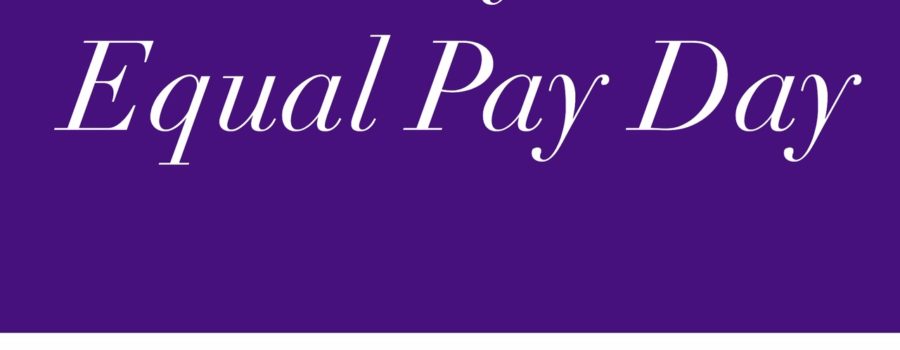Equal Pay Day 2020
Today is Equal Pay Day in the United States.
This means that women in the United States, on average, must work until Equal Pay Day, March 31, 2020 to earn what the average man in the United States earned by December 31, 2019.
This article in Forbes, “On Equal Pay Day What is the Real Gender Pay Gap” does a good job of breaking down many different ways women are discriminated against when it comes to pay. In particular, the article argues against those who say that the gender pay gap is overblown because it does not compare men and women at the same level and in the same job. The article argues that comparing women and men at the same level in the same job does not address widespread societal discrimination for the following reasons:
(1) Comparing employees at the same level ignores gender bias in promotions. There is substantial evidence that men get promoted at a faster pace than women.
(2) Comparing employees in the same industry ignores gender bias that leads to career choices. Girls and boys are steered towards different professions by their parents, teachers, peers, and societal messaging. This also ignores the fact that professions begin making less money when they become majority female. (See: https://www.nytimes.com/2016/03/20/upshot/as-women-take-over-a-male-dominated-field-the-pay-drops.html).
(3) Controlling for years of experience ignores gender bias in childcare.
These are some important arguments about why using this broader number to describe pay inequity in the United States in many ways makes more sense than comparing the earnings of men and women in equivalent jobs.
But how do the laws governing Equal Pay work?
Unfortunately, the laws governing equal pay do not fully address the larger issues raised above.
The main federal law governing equal pay, The Equal Pay Act, requires that men and women be given equal pay for equal work in the same establishment. At face value, this means that women and men performing substantially equal job duties must be paid equally. “Substantially equal job duties” takes into account the skill (experience, ability, education, training), effort (the amount of physical or mental exertion needed to perform the job), responsibility, and working conditions. The same establishment provision means that a male and female employee must work in the same physical establishment to merit comparison. For example, if a female and male employee had identical resumes and job requirements but one worked in a New York City office and another in a White Plains office of the same company, the Equal Pay Act would not require they receive equal compensation.
Even if a female employee can meet all the requirement detailed in the above paragraph, a Company may still pay a male employee doing the same job more than her if it can point to “any factor other than sex” that led to that pay discrepancy. This other factor can sometimes include that a man negotiated his salary “more effectively” than his female coworker. It could also cover a situation where a man and woman received unequal pay at one company and then move laterally to a new company. The new company continues to value the man more highly than the woman because of his higher past salary.
Many states and localities have sought to remedy some of the issues with the federal Equal Pay Act.
One way States and Cities have sought to remedy this is through Salary History Bans. As of February 2019, 13 states, including New York and New Jersey, and 10 localities including, New York City, Albany County, Westchester County, and Suffolk County have all banned employers from asking job applicants about their salary histories in previous jobs. Banning salary history questions helps women break free from the pay discrimination of one employer when they move into a new job. Employers are generally still allowed to ask prospective employees about their salary requirements and expectations.
Beyond salary history bans, state and local laws eliminate other issues with the Equal Pay Act such as the single establishment requirement and the “any factor other than sex” affirmative defense. New Jersey’s new Equal Pay Act which became effective on July 1, 2018, contains no “any factor other than sex” defense for employers. It also allows employees to sue for equal pay using comparison rate differentials at any of an employer’s establishments. Finally, it provides strong protections for employees who discuss or disclose information about their rate of compensation with others, like their coworkers.
Besides the Equal Pay Act, Title VII of the Civil Rights Act and its State and Local Analogs provide some protections not found in the Equal Pay Act. Under these anti-discrimination laws, promoting men more quickly than women is illegal and actionable. This helps address the role gender bias in promotions plays in the gender pay gap.
These laws also prohibit companies from demoting and terminating pregnant women and those with caregiver responsibilities. This should help women maintain more similar levels of experience over time as their male colleagues.
Title IX, which prohibits sex discrimination in education, also has a role to play in combatting the gender pay gap. Specifically, Title IX places some limits on steering men and women into different professions during their years spent in school, by forcing schools to give girls and boys similar opportunities to develop the skills they will need to enter the job market.
Unfortunately, these laws are only as effective as their enforcement. Women who have been disadvantaged by unequal pay, gender bias in promotions, education, and discrimination related to pregnancies and caregiver responsibilities must stand up for their rights in order to push Equal Pay Day closer to December 31, where it should be. Companies and schools must comply with the law and go beyond it to create more equal workplaces. Government agencies that enforce civil rights laws, like the Equal Employment Opportunity Commission, Department of Labor, the Department of Education, and the New York City Commission on Human Rights, must receive more funding and competent leadership so they can fulfill their missions. Government agencies must also be allowed to move forward with common sense steps to combat equal pay such as the EEOC’s Obama era rule requiring Companies with over 100 employees to provide the government with information about how workers are paid broken down by gender, race, and ethnicity. The Trump administration froze this rule in 2016, but Federal Judge Tanya Chutkan ruled on March 4, 2019 that implementation of the rule must move forward. (See: https://nwlc.org/blog/we-sued-the-trump-administration-and-won/; https://www.bloomberg.com/news/articles/2019-03-06/u-s-companies-told-to-report-gender-racial-pay-data-to-eeoc; https://www.vox.com/2019/4/26/18515920/gender-pay-gap-rule-eeoc).
Lawmakers must improve and update the current laws to address gender pay inequality. They could begin by updating federal laws to include some of the improvements states and cities have passed in recent years. They could take steps to alleviate the child-care burden women shoulder by passing more robust parental leave laws that cover both men and women. Simultaneously, lawmakers could work to make childcare more affordable and widespread in the United States.
Thanks for reading. If you have other ideas for solving the Gender Pay Gap, share them in the comments.
Please subscribe to receive more employment Know Your Rights content by email.
If you have further questions about a specific incidence of discrimination, feel free to contact the Firm through the contact page: https://stephensnaphtal.com/contact/.


